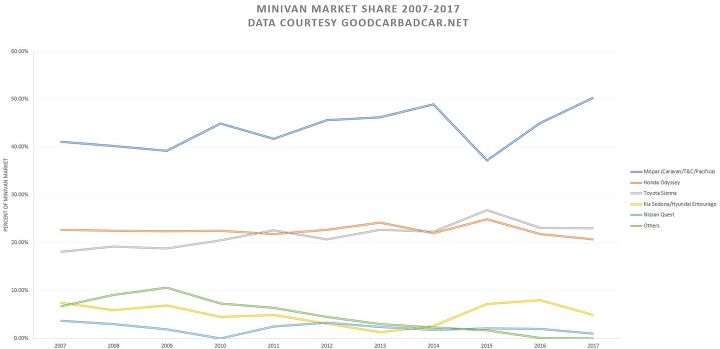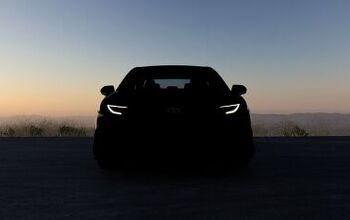2017 Toyota Sienna XLE AWD Review - Well-Aged Swagger

2017 Toyota Sienna XLE AWD
Yes, you read the headline correctly — this is indeed a review, running in June 2018, of a 2017 model year vehicle. Chalk it up to other priorities (after all, writing isn’t my full-time gig) but honestly, it doesn’t really matter in this case.
Toyota hasn’t really made significant changes its minivan since the early years of the Obama administration. Sure, minor details are always tweaked year over year, but the essence of the 2017 Toyota Sienna XLE AWD isn’t significantly different from that of the 2011 model. And that’s not a bad thing — no matter the age, minivan owners keep flocking back to the Swagger Wagon.
Take a close look (click to embiggen) at the data in the above chart if you don’t believe me. While the market for minivans has shrunk dramatically from over three quarters of a million vehicles in 2007 to 484,618 last year, the top three players have kept a stranglehold on their relative positions in the market. While FCA sells nearly one out of every two vans in the U.S., Toyota and Honda each move over 20 percent consistently, every single year. It’s a smaller pie than years ago, certainly, but it’s a loyal, steady pie indeed. Toyota is clearly doing well to maintain its position as a favorite.
Toyota has maintained a marketplace reputation as the standard for reliability, which has led to incredible owner loyalty. Driver controls throughout the Toyota lineup are remarkably similar, which makes moving from one model to another in the showroom an exercise in familiarity. For example, the same little cruise control stalk, jutting from the steering wheel at the four o’clock position, has been used in Toyota products for decades.
Similarly, many Toyota products, the Sienna included, use the same basic Entune touchscreen infotainment interface. It’s a bit dated, and occasionally is slow to respond to touch inputs, but it simply works.
One perceived quality issue appeared: the sound of the doors when slammed. Perhaps I expect too much of a vehicle built by the same folks who offer vault-like door shut experiences in upmarket Lexus models, but when the kid slammed the passenger door upon school drop-off, a hollow rattle echoed through the body structure. Again, it’s likely more of a perception thing rather than an actual quality problem, but when spending over $40,000 on a car I’d hope it’d sound a little less tinny.
Toyota is an outlier in the van market with its option of all-wheel drive. In colder climates, the extra traction afforded by a second set of driven wheels is always welcome. However, the drag of the additional drivetrain and the additional 250-ish pounds blunts the fuel economy ratings by around two miles per gallon, per the EPA. The 19.2 mpg I observed in my week with the all-wheel drive Sienna was thus a bit disappointing. I’m sure that had the winter been worse here in Ohio, I’d have appreciated the grip.
The driving experience was unremarkable — which in a van is a desirable trait. The newer vans from Chrysler and Honda are better insulated from road and wind noise than this Sienna, but it’s never objectionably loud, even at interstate speeds. Road imperfections are well damped, though deep potholes will be felt and heard throughout the cabin.
[Get new and used Toyota Sienna pricing here!]
Seating was quite comfortable in all three rows, though leg room was typically a bit tight in the third row for my tall frame. Most normal-sized adults would do fine in the wayback for short trips, and kids will be perfectly content back there. The second row captain’s chairs are almost too comfortable — my kids didn’t want to go back to the thinly-padded seats in my Town & Country.
Styling? Well, the Sienna has been around for most of a decade. It’s still reasonably attractive, but it’s so incredibly familiar that you’ll lose it in the parking lot or the school drop-off lane if you don’t put distinct stick family stickers in the rear window. The maroon finish on my tester seemed purpose-mixed to blend into the background.
My wife is the “cookie mom” for each of my daughters’ Girl Scout troops, which means she needs to pick up EVERY SINGLE CASE of cookies each girl in the troop sells before distributing them among the girls. We’ve found over the years that a minivan (or two) is necessary for hauling the morsels of sugar and happiness in one trip. Folding the third row, and flip/sliding the second row of seats reveals a wide load floor ready to accept plenty of stuff. The Sienna doesn’t have the flattest floor when the seats are up — a few bumps where the seats fasten can eat up a little bit of space — but we easily fit 145 cases of cookies in the roomy Sienna.
I may be biased — after all, I’m one of those weirdos who is a member of TWO minivan-specific internet forums. I drive a 2012 Chrysler Town & Country daily, and have owned a pair of Honda Odysseys as well. But I’ve said it before — the minivan is the perfect family vehicle. Whether the cargo is human, canine, furniture, or lumber, the flexibility and space afforded by a low load floor and high roof make the form superior to any crossover. And the Toyota Sienna, no matter the model year, does it as well as any other van out there.
[Images: © 2018 Chris Tonn; Sales chart via Excel with data from GoodCarBadCar.net]

Some enthusiasts say they were born with gasoline in their veins. Chris Tonn, on the other hand, had rust flakes in his eyes nearly since birth. Living in salty Ohio and being hopelessly addicted to vintage British and Japanese steel will do that to you. His work has appeared in eBay Motors, Hagerty, The Truth About Cars, Reader's Digest, AutoGuide, Family Handyman, and Jalopnik. He is a member of the Midwest Automotive Media Association, and he's currently looking for the safety glasses he just set down somewhere.
More by Chris Tonn
Latest Car Reviews
Read moreLatest Product Reviews
Read moreRecent Comments
- ToolGuy 9 miles a day for 20 years. You didn't drive it, why should I? 😉
- Brian Uchida Laguna Seca, corkscrew, (drying track off in rental car prior to Superbike test session), at speed - turn 9 big Willow Springs racing a motorcycle,- at greater speed (but riding shotgun) - The Carrousel at Sears Point in a 1981 PA9 Osella 2 litre FIA racer with Eddie Lawson at the wheel! (apologies for not being brief!)
- Mister It wasn't helped any by the horrible fuel economy for what it was... something like 22mpg city, iirc.
- Lorenzo I shop for all-season tires that have good wet and dry pavement grip and use them year-round. Nothing works on black ice, and I stopped driving in snow long ago - I'll wait until the streets and highways are plowed, when all-seasons are good enough. After all, I don't live in Canada or deep in the snow zone.
- FormerFF I’m in Atlanta. The summers go on in April and come off in October. I have a Cayman that stays on summer tires year round and gets driven on winter days when the temperature gets above 45 F and it’s dry, which is usually at least once a week.













































Comments
Join the conversation
It's the middle row seats that killed the Sienna for me. My kids are in their early/mid teens, slender of build and a little over 5 feet tall. Both of them found the middle row head restraints pushed their heads forward at an uncomfortable angle. If you're taller and fatter, as I am, your body thickness will keep your head lined up properly with the restraint. In one used '17 Sienna I tried, the headrest (uh, restraint) had been turned backward by a previous user. That modification of a safety device will get you into legal/insurance trouble in the event of an injury. Similarly, tilting the seat back too far means that in an accident the seatbelt will ride up over your hip bones and crush your internal organs. The sales person at the dealership tilted the seat backs slightly and advised the girls to not wear their hair in a bun. Great.
No good when compared to previous 1998 and 2006 6 speed trans versions. I have developed a phobia for anything but flat roads. Around town, a slight incline at slow speeds, i.e. 1000-1500 rpm produces a slow and jerky acceleration in 2nd and 3rd. Add jerky upshift/ downshifts at higher road speeds. Peppyness of previous versions was fun. But two dealers are at a loss to correct it, with no factory help forthcoming. Manually shifting has become the only consolation. Eight speed 2018 is said to have no remedial updates.